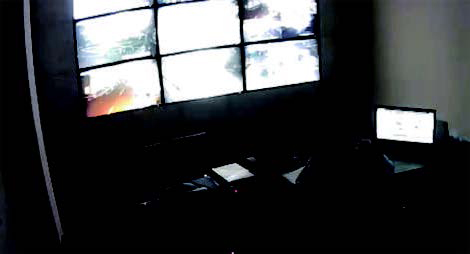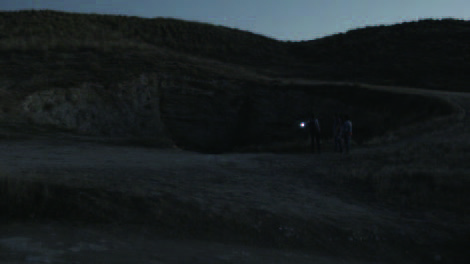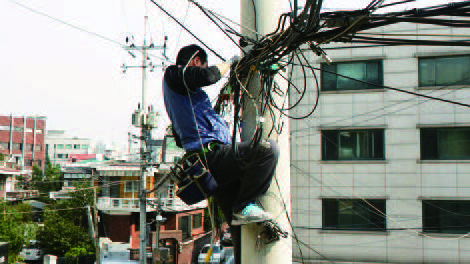The National Art Center, Tokyo, is pleased to present the Exhibition entitled Universal / Remote from Wednesday, March 6, 2024, to Monday, June 3, 2024.
Universal / Remote is an exhibition that examines various things and phenomena which have entered the spotlight, or come to our attention for the first time, amid the COVID-19 pandemic.
The exhibition is intended to reframe themes often explored in contemporary art thus far, such as global capitalism and digital society, from the two perspectives of worldwide scale (as expressed by the word “universal” as well as the prefix “pan-,” which appears in many words including “pandemic” ) and non-face-to-face isolation (as in “remote” work, school and so forth).
Most of the works to be exhibited were produced before 2020 but in conveying comical aspects of the excesses of surveillance and high-tech networks, as well as the profound isolation of human beings, these works seem to grapple head-on with the current era and with the post-COVID world of the future.
ABOUT THE EXHIBITION
Since the late 20th century, people, capital, and information came to move on a global scale. We entered a new phase in the 2010s along with the proliferation of smart devices and issues such as excessive tourism, shifting of industryʼs production costs and environmental impact to developing nations, the digital divide and so forth were only worsening as the 2020s dawned. And while the outbreak of a pandemic that recognizes no borders suddenly put the brakes on the movement of people, the limitless flow of capital and information showed no sign of stopping. In fact, it seems we are seeing the true visage of capital and information systems for the first time. The rich and the poor, the powerful and the powerless: imbalances in our world are becoming more explicit all the time.
The exhibition title Universal / Remote references prevailing conditions in the 21st century as capital and data flow freely on a global scale. Conveying comical aspects of the excesses of surveillance and high-tech networks, as well as the profound isolation of human beings, works in this exhibition seem to grapple head-on with the current era and with the post-COVID world. The exhibition presents the works of 8 artists and a group of 3 artists that address the state of society in the 21st century as shaped by the conditions described above, focusing on two concepts, “Constant Growth at a Pan-Global Scale” and “The Remote Individual.”
Term: March 6 (Wed), 2024 – June 3 (Mon), 2024
Open: 10 am – 6 pm *10:00-20:00 on Fridays and Saturdays
(Last admission 30 minutes before closing)
Closed: Tuesdays *Open on April 30 (Tue.) instead
The National Art Center, Tokyo official website: https://www.nact.jp/english/
ARTISTS
Daisuke Ida
Born in Tottori, Japan in 1987. Lives and works in Tokyo. He earned an MFA in sculpture from Tokyo University of the Arts in 2015 and completed MAD Art Practice in 2016.
While repeatedly returning to the classics of sculpture, Ida uses a variety of media to question what sculpture is. Three video works, For Whom the Bell Tolls?, IKAROS and Fever are presented as a trilogy depicting three phenomena – flying, ascending, and falling (or collapsing) – which Ida composed for this exhibition.

Daisuke Ida, For Whom the Bell Tolls?, 2021 Video (loop) © Daisuke Ida Courtesy of the Artist
Xu Bing
Born in Chongqing, China in 1955. Lives and works in Beijing and New York. He earned an MFA from the Central Academy of Fine Arts (CAFA) in Beijing 1987.
Xu’ s first moving image work, Dragonfly Eyes, is a film that stitches together 11,000 hours of footage from surveillance cameras freely available on the internet.

Xu Bing, Dragonfly Eyes, 2017 Video, surveillance camera footage taken from public live-streaming websites (81min) © Xu Bing Studio Courtesy of the Artist
Trevor Paglen
Born in Maryland, USA in 1974. Lives and works in Berlin and New York. He holds an MFA from the School of the Art Institute of Chicago and a Ph.D. in Geography from the University of California, Berkeley.
Paglen’ s main interests are geography, military secrets, surveillance and communication systems, and AI-generated images. He presents three photographic series in this exhibition: Landing Sites, Undersea Cables, and Hallucinations.

Trevor Paglen, NSA-Tapped Fiber Optic Cable Landing Site, Mastic Beach, New York, United States 2015 C-Print, 121.9×152.4 cm © Trevor Paglen Courtesy of the artist, Altman Siegel, San Francisco, and Pace Gallery, New York
Hito Steyerl
Born in Munich, Germany in 1966. Lives and works in Berlin. Steyerl studied documentary film at the Japan Institute of the Moving Image and the University of Television and Film Munich. She holds a Ph. D. in Philosophy from the Academy of Fine Arts Vienna in 2003.
Giorgi Gago Gagoshidze
Born in Kutaisi, Georgia in 1983. Lives and works in Berlin. He studied fine arts at the State Academy of Arts in Tbilisi (2001–2007) and the Royal Academy of Fine Arts in The Hague (2008–2010), as well as experimental film and video with Hito Steyerl at the Berlin University of the Arts (2012–2016).
Miloš Trakilović
Born in Tuzla, Bosnia and Herzegovina in 1989. Lives and works in Berlin and Amsterdam. He studied fine arts at Willem de Kooning Academy in Rotterdam (2009–2012) and experimental film and video with Hito Steyerl at the University of the Arts in Berlin (2012–2016).
Steyerl has been working on video works about the circulation of images in social conditions such as digital technology and global capitalism. She presents Mission Accomplished: Belanciege together with Giorgi Gago Gagoshidze and Miloš Trakilović.

Giorgi Gago Gagozhidze, Hito Steyerl, Miloš Trakilović, Mission Accomplished: Belanciege, 2019 3 channel HD video (color, sound), encironment (47min 23s) Exhibition view Neuer Berliner Kunstverein (n.b.k.): Hito Steyerl, MISSION ACCOMPLISHED: BELANCIEGE, 2019 video installation, environment, written and co-produced by Giorgi Gago Gagoshidze, Hito Steyerl, and Miloš Trakilović. Courtesy the artists; Neuer Berliner Kunstverein, Berlin; Andrew Kreps Gallery, New York; Esther Schipper, Berlin. Photo © Neuer Berliner Kunstverein (n.b.k.) / Jens Ziehe
Maiko Jinushi
Born in Kanagawa, Japan in 1984. Lives and works in Tokyo. She earned an MFA from the Tama Art University, Tokyo, in 2010 and participated in the Jan van Eyck Academie residency in 2019-20.
Jinushi describes her work, which combines elements including video art, performance, and text, as “a new form of literary experience.” A Distant Duet is a five-part video piece that resembles a letter to the poet and novelist Roberto Bolaño, whom she considers her “spiritual lover.”

Maiko Jinushi, A Distant Duet, 2016 HD video(40min) © Maiko Jinushi Courtesy of HAGIWARA PROJECTS
Tina Enghoff
Born in Denmark in 1957. Lives and works in Copenhagen. She studied photography at the International Center of Photography (ICP) in New York. Enghoff focuses on societal issues such as structural violence within the welfare state. In Possible Relatives, a photographic
series of the rooms of people who had died alone, she questioned the loneliness in the city.

Tina Enghoff, Possible Relatives / Man born 1954, deceased, found in home February 14 2003, 2004 Archival pigment print, 120×160×5cm © Tina Enghoff Courtesy of the Artist
Jeamin Cha
Born in South Korea in 1986. Lives and works in Seoul. She earned a BFA from the Korea National University of Arts in 2010 and an M.A. from the Chelsea College of Design and Arts, London, UK, in 2011.
Chroma-key and Labyrinth depicts the labor of individuals supporting the invisible infrastructure of cables underpinning South Korea, a society that prides itself on being extremely online.

Jeamin Cha, Chroma-key and Labyrinth, 2013 Single channel HD video (color, sound, 15 min) © Jeamin Cha Courtesy of the Artist
Evan Roth
Born in Michigan, USA in 1978. Lives and works in Berlin. He holds a B.S. in architecture from the University of Maryland and an MFA in Design & Technology at Parsons.
Roth applies the notion of the hack into art making. The immersive installation Since You Were Born, which utilizes images stored in his computer’ s cache, captures a new form of self-portrait.

Evan Roth, Since You Were Born, 2023 Custom wallpaper, dimensions variable Installation View of the MOCA Jacksonville: Since You Were Born, 2019 © Evan Roth Courtesy of the MOCA Jacksonville Photo by Doug Eng
Natsuko Kiura
Born in Kagoshima, Japan in 1985. Lives and works in Kagoshima. She earned an MFA from Onomichi City University in Art & Design in 2010.
Kiura consistently paints landscapes, especially everyday scenes, in oil. In this exhibition, she expands new landscapes by composing paintings of various sizes, including new works.
Term: March 6 (Wed), 2024 – June 3 (Mon), 2024
Open: 10 am – 6 pm *10:00-20:00 on Fridays and Saturdays
(Last admission 30 minutes before closing)
Closed: Tuesdays *Open on April 30 (Tue.) instead
The National Art Center, Tokyo official website: https://www.nact.jp/english/

Natsuko Kiura, Park, 2021 Oil on canvas, 97×145.5cm © Natsuko Kiura Courtesy of the Artist Photo © EUREKA
VENUE ACCESS
Tokyo Metro Chiyoda Line, Nogizaka Station (COS), direct access from Exit 6
Tokyo Metro Hibiya Line, Roppongi Station (H04), approximately 5-minute walk from Exit 4a
Toei Oedo Subway Line, Roppongi Station (E23), approximately 4-minute walk from Exit 7
*No parking
The National Art Center, Tokyo (NACT)
7-22-2 Roppongi, Minato-kn, Tokyo 106-8558
Inquiries: (+81) 47-316-2772 (Hello Dial)
Official website
TOURING INFORMATION
Kumamoto: Contemporary Art Museum Kumamoto; October 7 (Sat.) – December 17 (Sun.), 2023
Hiroshima: Hiroshima City Museum of Contemporary Art; June 29 (Sat.) – September 1 (Sun.), 2024
About the National Art Center, Tokyo (NACT)
The National Art Center, Tokyo was founded in 2007 with the mission of contributing to the creation of a new culture that advances mutual understanding and inclusion through the power of art. Since then, the NACT–the fifth institution to be established under the Independent Administrative Institution National Museum of Art–has functioned as an art center without permanent collections that provides the public with a place where they can experience many different forms of artistic expression, make new discoveries, and share diverse values. In addition to hosting a broad spectrum of art shows in one of Japan’s largest art exhibition spaces, the NACT also collects, provides, and makes publicly accessible diverse art information/resources and runs various educational and public programs.

